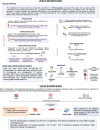Biorepositories For Global Rare Disease Research: A Narrative Review
- PMID: 40397074
- PMCID: PMC12095354
- DOI: 10.1007/s11926-025-01189-6
Biorepositories For Global Rare Disease Research: A Narrative Review
Abstract
Purpose of this review: Rare diseases, although individually infrequent, collectively impact a substantial number of people. Collaborative translational research using biospecimens is essential for advancing our understanding of the diverse characteristics and pathophysiology of rare diseases. Biobanks play a pivotal role in this endeavor by collecting, processing, transporting, and storing biospecimens, thereby serving as invaluable resources for medical research. In this review, we explore currently available biobanks, with a specific focus on those dedicated to rare rheumatic diseases. We also examine accessible best practice guidelines for establishing and maintaining high-quality biobanks, discuss the limitations and propose future directions for enhancing biobanking efforts in rare disease research.
Recent findings: Advances in molecular and genomic technologies have expanded the role of biobanks, enhancing biomarker discovery and precision medicine. However, despite growth in biobanking capabilities, key challenges persist concerning ethics, interoperability, and biospecimen exchange, prompting active responses by various regulatory and governing bodies. Biobanking has transformed rare disease research. Strengthening national and international collaborations is essential for driving progress in this field and accelerating the development of novel therapeutic and precision medicine approaches.
Keywords: Biobank; Biospecimen; Connective tissue disease; Myopathies; Myositis; Rare disease.
© 2025. The Author(s).
Conflict of interest statement
Declarations. Disclosures: LG and CL co-lead the MIHRA biospecimen core. The views and opinions expressed belong to the authors and do not necessarily reflect those of the organizations with which they are affiliated. LAS: Abbvie, Argenx, aTyr Pharmaceuticals, Boehringer Ingelheim, CSL Behring, EMD Serono, Horizon Pharmaceuticals, Kadmon Pharmaceuticals, Kinevant Pharmaceuticals, Mallinckrodt Pharmaceuticals, Pfizer Inc, Priovant Pharmaceuticals, U.S. Department of Defense. Human and Animal Rights and Informed Consent: This article does not contain any studies with human or animal subjects performed by any of the authors. Conflict of Interest: The authors declare no competing interests.
Figures
References
-
- The Lancet Diabetes Endocrinology null. Spotlight on rare diseases. Lancet Diabetes Endocrinol. 2019;7(2):75. - PubMed
-
- Rheumatology TL. Long-awaited action on rare diseases. The Lancet Rheumatology. 2022;4(4):e229. - PubMed
-
- Graham CE, Molster C, Baynam GS, Bushby K, Hansson M, Kole A, et al. Current trends in biobanking for rare diseases: a review. Journal of Biorepository Science for Applied Medicine. 2014;21(2):49–61.
-
- Gasparyan AY, Ayvazyan L, Blackmore H, Kitas GD. Writing a narrative biomedical review: considerations for authors, peer reviewers, and editors. Rheumatol Int. 2011;31(11):1409–17. - PubMed
Publication types
MeSH terms
LinkOut - more resources
Full Text Sources
Medical
Research Materials


